Vienna, Austria – Thursday, March 25th, 2010
Competitive markets are supposed to be the Greatness and Glory of an infinitely perfect God as incarnate through supply and demand grids. This is what they teach you in Economics 101. If mankind were denied the free competition of even one of the thousand different brands of cereal, then not only have the terrorists won but they’ve begun looking at paint swatches to redecorate your foyer with. This is fact, while silly things such as evolution and gravity remain just as theories. Without competition free of any governing organizing body which can have an influence on the naturally occurring supply and demand slopes, you get monopolies, high prices, reduced output, lowered quality standards, a disincentive towards innovation, greedy executives, slothful employees, wrathfully envious middle-managers, and a trend towards mercantilism, socialism, communism, atheism, Nazism, CO2 emissions, famine, bubonic plagues, cancer, the defeat at Waterloo, and Theme Park Review becoming the most popular online coaster fansite. Free-market capitalism will automatically fix all of these problems and more, plus it includes a free oil change on your first visit.
So then tell me, why is it that on my visit to the Wiener Prater – the one park in the world that best embodies the ideal of free-market capitalism through the decentralized organization of competing showmen building and operating each ride independently of each other on open, public grounds – 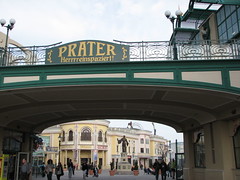 I am spending much more money to go on fewer attractions of lower quality?
I am spending much more money to go on fewer attractions of lower quality?
I arrived shortly after 4:00pm to discover the park was not that busy (although it was a Thursday in early season). Since I had skipped lunch I made the first item on my agenda to order a pizza and Viennese sausage from Salamucci, one of the nicer-looking food bars near the entry gate. When one eats alone in silence while in a foreign city, be assured that that individual’s mind is not sitting as passively as they themselves are. In this case, my initial calculations of how to best distribute my money and time over the next several hours quickly led me onto an internal discussion on one of my more favorite topics, the philosophy of economics.
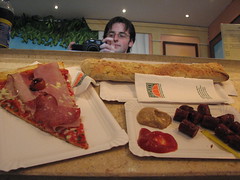 Economists are interesting people. They are at once simultaneously business people and philosophers, and yet for the most part they fail to be either. Generally only a few levels above being dirt-poor themselves, they have chosen a profession in which they concern themselves with larger theoretical questions of how a society should organize itself rather than the more pragmatic question of ‘how can I make the most money’ in regular business schools; yet all-too frequently they leave huge, fundamental
Economists are interesting people. They are at once simultaneously business people and philosophers, and yet for the most part they fail to be either. Generally only a few levels above being dirt-poor themselves, they have chosen a profession in which they concern themselves with larger theoretical questions of how a society should organize itself rather than the more pragmatic question of ‘how can I make the most money’ in regular business schools; yet all-too frequently they leave huge, fundamental 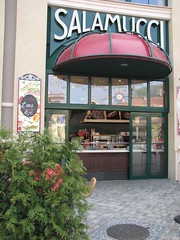 assumptions concerning a particular economic theory unquestioned and unprovoked in a way that has had real philosophers cringing for centuries on end. Where is it that a population’s preferences for particular goods and services come from when they take their money on the free market? Is the distribution of resources in increasing correspondence with those who have earned the most money an ethical imperative towards the just compensation of one’s societal value, or is it merely a pragmatic tool to encourage increased levels of production? Is maximizing the quantity output of quality goods and services the one objective that an entire nation should be directed towards, and if so, by whom was that decided? Few economists are willing to answer these questions, at least not while still wearing the hat of an economist. So while I am at it, let me ask a few questions about the economic organization and distribution of amusement rides at the Prater. First, a couple of observations:
assumptions concerning a particular economic theory unquestioned and unprovoked in a way that has had real philosophers cringing for centuries on end. Where is it that a population’s preferences for particular goods and services come from when they take their money on the free market? Is the distribution of resources in increasing correspondence with those who have earned the most money an ethical imperative towards the just compensation of one’s societal value, or is it merely a pragmatic tool to encourage increased levels of production? Is maximizing the quantity output of quality goods and services the one objective that an entire nation should be directed towards, and if so, by whom was that decided? Few economists are willing to answer these questions, at least not while still wearing the hat of an economist. So while I am at it, let me ask a few questions about the economic organization and distribution of amusement rides at the Prater. First, a couple of observations:
1): There are many empty seats being cycled on rides which represent an excess of capacity.
2): There people on the midways (including, most importantly, myself) whose demand for more rides are exceeded by what they are being supplied given their financial limitations.
3): There is almost no marginal cost to suppliers depending on whether those seats are occupied or vacant.
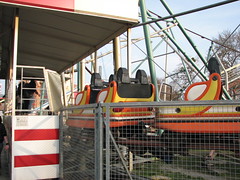 This is, in economics, an absurdity. If there is excess capacity for suppliers and excess demand for buyers, then they should always satisfy each other until either the supply and/or the demand is fully exhausted. A staunch supporter of free-market capitalism will probably tell me that there is either some form of collusion or price-fixing which shouldn’t occur in a purely competitive environment, as a free-market will always adjust to a price which ensures the demand meets the supply, and vice-versa. I am willing to posit a different theory in which the perfectly competitive market is the cause, not the solution, to why the prices won’t adjust downward to balance supply and demand. Here are a few more observations about the nature of the consumer (i.e. me).
This is, in economics, an absurdity. If there is excess capacity for suppliers and excess demand for buyers, then they should always satisfy each other until either the supply and/or the demand is fully exhausted. A staunch supporter of free-market capitalism will probably tell me that there is either some form of collusion or price-fixing which shouldn’t occur in a purely competitive environment, as a free-market will always adjust to a price which ensures the demand meets the supply, and vice-versa. I am willing to posit a different theory in which the perfectly competitive market is the cause, not the solution, to why the prices won’t adjust downward to balance supply and demand. Here are a few more observations about the nature of the consumer (i.e. me).
1): My demand for more rides given a price level of zero is approaching infinity (except in the case of the Zamperla Volare).
2): My marginal utility each additional ride is decreasing, especially after it has been added to my credit list.
3): My demand is highly elastic (economic jargon for “I am also incredibly cheap”), and I will not spend more money than I have to in order to get the minimum level of utility I expect out of the visit 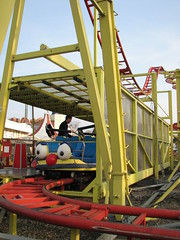 (i.e. all possible credits, plus a few culturally enriching activities).
(i.e. all possible credits, plus a few culturally enriching activities).
From these premises a model can then be drawn showing that a customer will respond to a linear reduction in price with an increase in usage that is exponential, but in a way that sees a linear decrease in the total amount of money spent. I.e. the combination of cheapness and decreasing marginal utility for re-rides after I have credited them once will see that I am willing to spend up to €4 to ride the Megablitz once but no more; when the price level drops to €1.5 I will then ride it twice; to €.80 then three time, to €.50 then four times, to €.10 then ten times, and at €0 my willingness for re-rides approaches infinity, given a policy that doesn’t involve re-queuing each time. This concludes that the current price level which forces both an excess of supply and demand is the level that maximizes profit for each showman.
 Traditionally, economists will tell you that at whatever price level the supply and demand curves naturally intersect in a perfectly competitive market is where the story ends. Everything is maximized to its fullest potential, and the pie is now fixed so it is not possible for either party to gain more without the other giving up some. The problem is that there are still spectators standing on the sidelines watching empty seats being cycled, wishing they could be in one of those seats but cannot because it will cost them too much money. Worst yet, those that are on the ride will find that with a mostly empty train, it doesn’t run as fast and airtime is decreased, meaning they had to pay more for a product that offers decreased utility than it would in a different economic system which ensures that every seat is filled and therefore the airtime is plentiful. This isn’t even beginning to explore the fact that the unstable nature of competitive markets ensures that every ride built at the Prater has to be cheaper and transportable in case they need to pack up and move out of town once market conditions change.
Traditionally, economists will tell you that at whatever price level the supply and demand curves naturally intersect in a perfectly competitive market is where the story ends. Everything is maximized to its fullest potential, and the pie is now fixed so it is not possible for either party to gain more without the other giving up some. The problem is that there are still spectators standing on the sidelines watching empty seats being cycled, wishing they could be in one of those seats but cannot because it will cost them too much money. Worst yet, those that are on the ride will find that with a mostly empty train, it doesn’t run as fast and airtime is decreased, meaning they had to pay more for a product that offers decreased utility than it would in a different economic system which ensures that every seat is filled and therefore the airtime is plentiful. This isn’t even beginning to explore the fact that the unstable nature of competitive markets ensures that every ride built at the Prater has to be cheaper and transportable in case they need to pack up and move out of town once market conditions change.
 From a systemic point of view, this competitive market system the Wiener Prater has produces some extraordinarily awful results. Total ridership numbers? Reduced. Average value to customers? Reduced. Total profits to the Prater as a whole? Even this is reduced, as I may have been willing to pay up to €50 for a pay-one-price scheme, but as it happened I had to stop at €40 once I did all the major attractions I wanted to see.
From a systemic point of view, this competitive market system the Wiener Prater has produces some extraordinarily awful results. Total ridership numbers? Reduced. Average value to customers? Reduced. Total profits to the Prater as a whole? Even this is reduced, as I may have been willing to pay up to €50 for a pay-one-price scheme, but as it happened I had to stop at €40 once I did all the major attractions I wanted to see.
What interests me is that I can’t imagine any way to fix these problems unless the competitive nature of the enterprise is compromised. A pay-one-price could be introduced, but then that would mean the hard work of some showmen who try to maintain their attractions to the highest quality would no longer be rewarded by a greater profit share from the public, while others would become free riders and let their maintenance or operating hours slip. The way around this I suppose is if somehow all the rides could collectivize into a single social entity, with the focus of providing the greatest overall guest experience possible given their resources taking precedence over the self-interest of each individual ride operator, to each roller coaster it’s needs, from each roller coaster it’s abilities, for the good of the entire Prater. But that would be approaching communism.
be rewarded by a greater profit share from the public, while others would become free riders and let their maintenance or operating hours slip. The way around this I suppose is if somehow all the rides could collectivize into a single social entity, with the focus of providing the greatest overall guest experience possible given their resources taking precedence over the self-interest of each individual ride operator, to each roller coaster it’s needs, from each roller coaster it’s abilities, for the good of the entire Prater. But that would be approaching communism.
Wow. Somehow this argument managed to turn a 200+ year old public park in Vienna into an icon for the evils of free-market capitalism and profit motive, while designating systems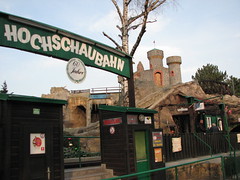 found in Six Flags or Cedar Fair parks as “approaching communism”. I think it must be time to finish my lunch and (for myself and the good of everyone that reads this site taking it the least bit seriously) start killing a few more of my braincells on the Prater’s various rides.
found in Six Flags or Cedar Fair parks as “approaching communism”. I think it must be time to finish my lunch and (for myself and the good of everyone that reads this site taking it the least bit seriously) start killing a few more of my braincells on the Prater’s various rides.
First up was the Hochschaubahn, a 1950-built scenic railway, recreated from a much earlier ride that was destroyed during WWII. Cost to ride was €2.50. Of all the rides in the Prater’s eclectic collection, the Hochschaubahn was the singular attraction that I most wanted to experience. It was to be my first scenic railway. We don’t have any in the United States. It’s a shame, really, as the scenic railway originates on the shores of Coney Island, and we certainly weren’t lacking in preservation-worthy installations such as the L.A. Thompson Scenic Railway at Venice Beach, California. Yet they are all gone, while Europe remains the home of seven (eight once the Dreamland ride reopens after restoration from the fire). Oddly enough, Europe has a relative dearth of traditional historic wooden coasters outside of Blackpool, while there remain plentiful surviving examples in North America, even with the singular surviving side-friction left in the world.
installations such as the L.A. Thompson Scenic Railway at Venice Beach, California. Yet they are all gone, while Europe remains the home of seven (eight once the Dreamland ride reopens after restoration from the fire). Oddly enough, Europe has a relative dearth of traditional historic wooden coasters outside of Blackpool, while there remain plentiful surviving examples in North America, even with the singular surviving side-friction left in the world.
At first this might seem an odd division of where the surviving classic wooden coasters are found (Europe keeps all the scenic railways while the US keeps all the exposed structure wooden thrill coasters), but in a way it does seem reflective of the respective cultures in each location. Even the name, “Scenic Railway”, despite having origins on US soil, seems to imply something more quintessentially European. Was my first experience on one of these rides to be everything I was hoping for?
Even the name, “Scenic Railway”, despite having origins on US soil, seems to imply something more quintessentially European. Was my first experience on one of these rides to be everything I was hoping for?
Well, not really. The Hochschaubahn is certainly “scenic”, although I still expected a bit more of a “coaster”, and this was almost more of a gravity-driven dark ride; the footprint and size of the building isn’t much larger than an average dark ride, at least. There were some drops, but many of the other turns were slow. If it weren’t for the fact that there were maybe all of two uphill sections beside the lift along the entire course, I’d have strongly feared a rollback at many points. There was one time towards the beginning when it picked up some momentum, but every time it tried navigating a curve that would seem to rob it of all its kinetic energy. I have to wonder if the long 5-bench trains are responsible, as I wouldn’t imagine they have the easiest time fitting the track around some of the tighter turns. One effect that did surprise me however were the spitting elves in one of the last tunnels which taller riders would have to duck to avoid getting their ears cleaned by a jet of water. I’m 5’10” and made it through dry with a hurried slouch while trying to protect my camera; anyone above 6’ consider yourself warned…
a curve that would seem to rob it of all its kinetic energy. I have to wonder if the long 5-bench trains are responsible, as I wouldn’t imagine they have the easiest time fitting the track around some of the tighter turns. One effect that did surprise me however were the spitting elves in one of the last tunnels which taller riders would have to duck to avoid getting their ears cleaned by a jet of water. I’m 5’10” and made it through dry with a hurried slouch while trying to protect my camera; anyone above 6’ consider yourself warned…
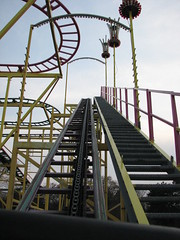 Second ride of the night was the nearby Wilde Maus. Price was €3.50. It’s a basic Maurer Söhne mouse model, although with almost no trim braking anywhere on the ride, it may also be the most white-knuckle intense coaster in the park. I attempted to take pictures during the ride but so many turns were brutally intense I was only able to get two shots off while the car was in motion. Thankfully the final brakes didn’t dig the lapbar into my gut as strongly as other mice are prone to do. The only other note I have about this ride was the odd paint scheme for the track alternated between pink and green, making me wonder if this might actually be a splicing of two separate mouse coasters into one.
Second ride of the night was the nearby Wilde Maus. Price was €3.50. It’s a basic Maurer Söhne mouse model, although with almost no trim braking anywhere on the ride, it may also be the most white-knuckle intense coaster in the park. I attempted to take pictures during the ride but so many turns were brutally intense I was only able to get two shots off while the car was in motion. Thankfully the final brakes didn’t dig the lapbar into my gut as strongly as other mice are prone to do. The only other note I have about this ride was the odd paint scheme for the track alternated between pink and green, making me wonder if this might actually be a splicing of two separate mouse coasters into one.
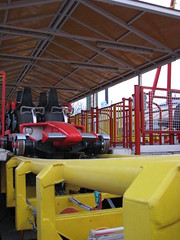 The Boomerang may have potentially been my next ride, but unfortunately it was closed for the entire length of my visit. Most enthusiasts will tell you that
The Boomerang may have potentially been my next ride, but unfortunately it was closed for the entire length of my visit. Most enthusiasts will tell you that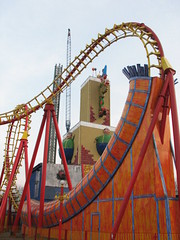 should be a cause for celebration, but this was perhaps the one Vekoma Boomerang in the world I would have most liked to try, for two reasons. One, it has a tunnel between the cobra roll and the vertical loop, and two, it features prototype trains with lapbar-only restraints. RCDb tells me these trains are from Schäfer Amusement Technology, a company I’ve never heard of before (although their website insists they’re involved with several large projects from other companies), and while generally lapbars are welcome over OTSHs,
should be a cause for celebration, but this was perhaps the one Vekoma Boomerang in the world I would have most liked to try, for two reasons. One, it has a tunnel between the cobra roll and the vertical loop, and two, it features prototype trains with lapbar-only restraints. RCDb tells me these trains are from Schäfer Amusement Technology, a company I’ve never heard of before (although their website insists they’re involved with several large projects from other companies), and while generally lapbars are welcome over OTSHs,  I have to wonder if a folded square steel piping is the most sensible design material to ensure increased comfort for riders. Since I never had the honor of spending €5
I have to wonder if a folded square steel piping is the most sensible design material to ensure increased comfort for riders. Since I never had the honor of spending €5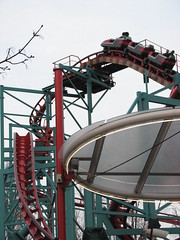 for a ride, I guess I’ll never know for myself.
for a ride, I guess I’ll never know for myself.
Vekoma wasn’t completely out of the picture despite the Boomerang’s closure, as my next ride ended up being the custom-designed MK-700 Megablitz. It seems to be designed in a style recalling the classic Schwarzkopf fairground coasters from the 70’s, with an evenly patterned layout piling helix on top of helix with bright red track and sky blue supports and a retro, multi-colored neon sign display. Unlike the original Schwarzkopf rides, it was not built for capacity, running only two, three-person cars (although they might fit up to six if smaller riders sit bobsled style). For the Wiener Prater, where each rider will be shelling over €4 for a single ride, this was more than enough capacity.
 It starts with a curving, righthand drop down and then back up into a spiraling downhill double helix which begins to pull some decently strong positive g’s around the bottom (accentuated more by the length of time they are sustained than by the force itself). It banks back uphill around the left before a short midcourse brake sends it diving down the only continuously straight drop on the entire ride. Another double-helix, this one uphill, is quite weak in terms of forces, and this feeds into a final, downhill triple-helix, which starts to see a few forces before it lets up on the upper ring to enter the final brakes. I hope that if I could have ridden a fully loaded train in the heat of summer the ride might have provided a bit more bite around each helix, although just the pure, curve-happy joy of the layout makes it oddball enough to warrant one ride,
It starts with a curving, righthand drop down and then back up into a spiraling downhill double helix which begins to pull some decently strong positive g’s around the bottom (accentuated more by the length of time they are sustained than by the force itself). It banks back uphill around the left before a short midcourse brake sends it diving down the only continuously straight drop on the entire ride. Another double-helix, this one uphill, is quite weak in terms of forces, and this feeds into a final, downhill triple-helix, which starts to see a few forces before it lets up on the upper ring to enter the final brakes. I hope that if I could have ridden a fully loaded train in the heat of summer the ride might have provided a bit more bite around each helix, although just the pure, curve-happy joy of the layout makes it oddball enough to warrant one ride, 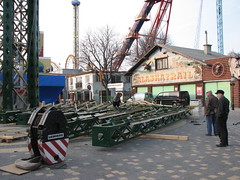 and the smooth tracking with open, unrestrictive cars make it one of, if not the best coaster in the park. Not that that’s saying too much.
and the smooth tracking with open, unrestrictive cars make it one of, if not the best coaster in the park. Not that that’s saying too much.
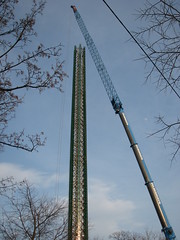 At this point I was mildly worried I might be megablitzing through my cash and list of rides to try too quickly to last the entire evening, so I slowed down and did some more exploring of the park, noting the oddly eclectic decorations and an under-construction Star Flyer, a sort of elevating flying-chairs ride, which would be towering some 117 meters (360 feet) in the air when complete. I just want to say: “Holy. Fucking. Shit.” It wasn’t even close to topped off yet and I was getting vertigo just looking up at it. I can’t imagine what it would be like for those that have actually had the chance to ride it. One interesting thing to note however was the active construction site around it had no barricades to block patrons on the midway from entering the ride site; anyone that wanted could go right up and touch the tower. Perhaps to native Austrians this is the
At this point I was mildly worried I might be megablitzing through my cash and list of rides to try too quickly to last the entire evening, so I slowed down and did some more exploring of the park, noting the oddly eclectic decorations and an under-construction Star Flyer, a sort of elevating flying-chairs ride, which would be towering some 117 meters (360 feet) in the air when complete. I just want to say: “Holy. Fucking. Shit.” It wasn’t even close to topped off yet and I was getting vertigo just looking up at it. I can’t imagine what it would be like for those that have actually had the chance to ride it. One interesting thing to note however was the active construction site around it had no barricades to block patrons on the midway from entering the ride site; anyone that wanted could go right up and touch the tower. Perhaps to native Austrians this is the  status quo, but it made me stop and think to myself, “never in America”.
status quo, but it made me stop and think to myself, “never in America”.
I also took a moment to grab a ride on Der Zug des Manitu, the Prater’s single steel children’s coaster. Cost for a credit: €1.80. It’s not too bad of a ride, surprisingly starting out of the station in reverse and traversing half the track before changing direction and motoring through four or five laps going forward. With some rather flat, tight turns it’s also just jarring enough that one might need to lightly hold on to the handle bar with one hand while trying to take pictures with the other.
 Back towards the entrance was the Super 8er Bahn, a jumbo non-looping coaster model from Pinfari. Any coaster with a Pinfari stamp of approval on it can be guaranteed to not be a device of the highest engineering quality, although the question can still remain over whether it might be a fun fairground romp or an updated tool used by the Spanish inquisition. Thankfully, the Super 8er Bahn is much more the former than the later. In fact, running through a quick mental list of Pinfari’s oeuvre, Super 8er Bahn might even take the cake for the best ride they’ve ever made. Tall, fast, long layout, occasionally
Back towards the entrance was the Super 8er Bahn, a jumbo non-looping coaster model from Pinfari. Any coaster with a Pinfari stamp of approval on it can be guaranteed to not be a device of the highest engineering quality, although the question can still remain over whether it might be a fun fairground romp or an updated tool used by the Spanish inquisition. Thankfully, the Super 8er Bahn is much more the former than the later. In fact, running through a quick mental list of Pinfari’s oeuvre, Super 8er Bahn might even take the cake for the best ride they’ve ever made. Tall, fast, long layout, occasionally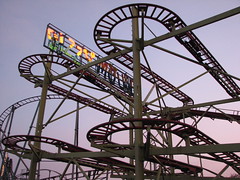 random forces from a mysterious source, and best of all, relatively smooth with comfortable, OTSH-free rolling stock. I’d have given it a second go if it wouldn’t have cost me another €4.
random forces from a mysterious source, and best of all, relatively smooth with comfortable, OTSH-free rolling stock. I’d have given it a second go if it wouldn’t have cost me another €4.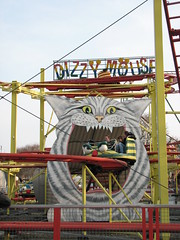
Immediately next door was the Dizzy Mouse, a Reverchon spinning mouse and also the second mouse coaster of the day. Unlike the Wilde Maus, this one lacked the intense laterals around the turns and sudden, suicidal dives, but the ride time lasts longer with the slower average speed and it includes spinning, which was only moderate on my cycle. In other words, everything I’d come to expect from this model. The one unexpected feature was a ‘cat’ tunnel on the final leg of the layout before the bunny hop. However, this proved to be better used as rationale to convince myself the €3.50 ticket would be worth it because it has a unique feature from other spinning mice, than it was on-ride where the tunnel was barely noticed.
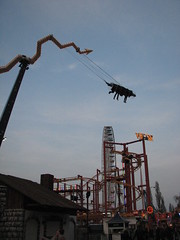 So far I had my focuses set solely on the roller coasters, but I had been taking mental notes on which of the flat rides and dark rides I passed might be worth taking a spin on. There were a couple old-school style ghost houses (Geisterschlosses, I think) which looked promising, but it was hard to tell which would be the one best worth the money, so I held off for the moment. There was an odd, cable-suspended inverting swing-type thing which looked cool, but at €5 a ride it didn’t look that interesting. The Star Flyer would have been a must-ride if it were completed, and the smaller model they already had installed I knew I’d be getting a chance to ride for free at Holiday Park in a couple days. A large, themed, elevated rapids/flume ride was one of the more attention-grabbing non-coasters on the Prater’s premises,
So far I had my focuses set solely on the roller coasters, but I had been taking mental notes on which of the flat rides and dark rides I passed might be worth taking a spin on. There were a couple old-school style ghost houses (Geisterschlosses, I think) which looked promising, but it was hard to tell which would be the one best worth the money, so I held off for the moment. There was an odd, cable-suspended inverting swing-type thing which looked cool, but at €5 a ride it didn’t look that interesting. The Star Flyer would have been a must-ride if it were completed, and the smaller model they already had installed I knew I’d be getting a chance to ride for free at Holiday Park in a couple days. A large, themed, elevated rapids/flume ride was one of the more attention-grabbing non-coasters on the Prater’s premises,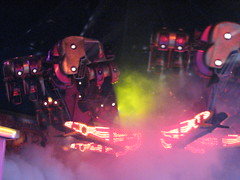 but the weather didn’t allow for operation yet. Extasy was by far the most insane flat ride I’ve ever seen, I nearly went on it but I literally feared it would be too intense for me. I wasn’t even comfortable standing too close to it because if someone were to heave, it would be sent flying out of the ride area. Other classic flat rides all appeared to offer above-average cycles, but again, it was hard to muscle the resolve to put down 2 to 3 euro on the counter for something I’ve been on before. There was one ride, however, which I decided I could not pass up. The Tagada.
but the weather didn’t allow for operation yet. Extasy was by far the most insane flat ride I’ve ever seen, I nearly went on it but I literally feared it would be too intense for me. I wasn’t even comfortable standing too close to it because if someone were to heave, it would be sent flying out of the ride area. Other classic flat rides all appeared to offer above-average cycles, but again, it was hard to muscle the resolve to put down 2 to 3 euro on the counter for something I’ve been on before. There was one ride, however, which I decided I could not pass up. The Tagada.
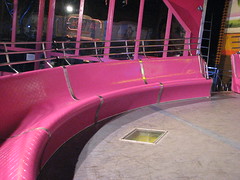 Basically how it works is, there’s a giant disk which spins tilted at slight axis while bouncing up and down. Around the outside of the disk are the benches which face inward. There are no seat dividers. There are no individual seats molded around the continuous bench. There are no restraints. There are no seatbelts. There is nothing to hang onto except for an outside railing along the bench behind you and the friction created between moist palms and a smooth, plastic bench covering. I’ve said it a couple times before but it needs to be reiterated here: Never in America. (Okay, maybe also: holy fucking shit. However, more in a “that’s cool!” way rather than “that’s scary” as was the prospect of a 300ft. chair swing. But maybe a little bit scary, too…)
Basically how it works is, there’s a giant disk which spins tilted at slight axis while bouncing up and down. Around the outside of the disk are the benches which face inward. There are no seat dividers. There are no individual seats molded around the continuous bench. There are no restraints. There are no seatbelts. There is nothing to hang onto except for an outside railing along the bench behind you and the friction created between moist palms and a smooth, plastic bench covering. I’ve said it a couple times before but it needs to be reiterated here: Never in America. (Okay, maybe also: holy fucking shit. However, more in a “that’s cool!” way rather than “that’s scary” as was the prospect of a 300ft. chair swing. But maybe a little bit scary, too…)
 In my opinion the primary value of flat rides is almost entirely social, as I generally don’t find much is gained from them if I’m just riding it for my own amusement. Such a set-up as found on the Tagada then possibly makes this the ultimate flat ride, as there are essentially an infinite number of ways to interact with it and with others who also (against their better judgment) also decided to ride. In this instance the ride operators even ask for your name so they can call out to you on the loudspeaker during the ride cycle. Unfortunately there were only two other girls on my cycle (again, curses to competitive economic theory, not that the ride might have been too busy this time of night anyway), but it was still one of the better things I experienced the whole evening at the Prater. I have to wonder how such rides manage to operate when it seems the potential for accidents might be pretty high, but I suspect it might be that the culture knows how to assess risk on their own and then behave in a way that will minimize that risk, rather than in the States where the assumption when there are no explicit rules is to behave as you always do wherever you are and then sue when that results in injury. Then again, the girls on my cycle were switching positions, standing,
In my opinion the primary value of flat rides is almost entirely social, as I generally don’t find much is gained from them if I’m just riding it for my own amusement. Such a set-up as found on the Tagada then possibly makes this the ultimate flat ride, as there are essentially an infinite number of ways to interact with it and with others who also (against their better judgment) also decided to ride. In this instance the ride operators even ask for your name so they can call out to you on the loudspeaker during the ride cycle. Unfortunately there were only two other girls on my cycle (again, curses to competitive economic theory, not that the ride might have been too busy this time of night anyway), but it was still one of the better things I experienced the whole evening at the Prater. I have to wonder how such rides manage to operate when it seems the potential for accidents might be pretty high, but I suspect it might be that the culture knows how to assess risk on their own and then behave in a way that will minimize that risk, rather than in the States where the assumption when there are no explicit rules is to behave as you always do wherever you are and then sue when that results in injury. Then again, the girls on my cycle were switching positions, standing, trying to walk across the center, etc; while the operators tried to time the bouncing in such a way that they could throw them off their feet, so maybe that’s not the best theory to posit in this scenario, and Austrians simply don’t care if there happen to be a few more accidental deaths each year when it comes at the expense of everyone else’s fun.
trying to walk across the center, etc; while the operators tried to time the bouncing in such a way that they could throw them off their feet, so maybe that’s not the best theory to posit in this scenario, and Austrians simply don’t care if there happen to be a few more accidental deaths each year when it comes at the expense of everyone else’s fun.
Speaking of fun (and/or accidental deaths) there was one more major coaster I needed to ride before the night was out: the Zamperla Volare, creatively named “Volare”! Now while I might be a fairly hard judge on good coasters, I tend to be a bit softer towards coasters most other people would call out-and-out deplorable. Even bad coasters have something to offer that makes at least one ride worthwhile, if only to find out just how bad it is. While I can’t say that there are any rides I’ve been on that still to this day I claim I regret doing (overly-long queues or breakdowns aside), if I were to target one in particular for such a thing, it would probably be my first and (until today) only experience with a Zamperla Volare, way back in 2002 when I made a singular lap on the then-brand new and prototype Flying Machine at  Six Flags Elitch Gardens in Denver. That entire day still probably ranks as one of my worst park experiences ever, and the Flying Machine ranked high as one of the instigating causes, not least because I was only a year-and-a-half off from open heart surgery, and a ride that put constant pressure on my chest with a poorly designed resting pad featuring a hard crest down the middle left me feeling sore and a bit worried for the next twenty minutes. The only other near-encounter I had with a Volare came three years later at Canada’s Wonderland, but we decided to skip it due to long lines.
Six Flags Elitch Gardens in Denver. That entire day still probably ranks as one of my worst park experiences ever, and the Flying Machine ranked high as one of the instigating causes, not least because I was only a year-and-a-half off from open heart surgery, and a ride that put constant pressure on my chest with a poorly designed resting pad featuring a hard crest down the middle left me feeling sore and a bit worried for the next twenty minutes. The only other near-encounter I had with a Volare came three years later at Canada’s Wonderland, but we decided to skip it due to long lines.
After paying my €4 admission, I stepped up into the car and was pleased to find that the padding had at least improved since the prototype version. There are no restraints in the 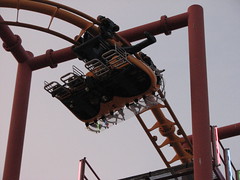 traditional sense to speak of, you just step onto a small ladder at the base of the car until your head fits into the birdcage at the top, and then a metal cage wall folds down behind you and the car tips forward into the flying position. There’s nothing behind your feet to keep you from stepping off the ladder and slipping out during an uphill climb, but hopefully the ride won’t be so bad that you have any reason to will that, (P.S. if I made it sound unsecure, I don’t believe it is any less safe than a coaster that posts common sense “Do not stand up” signs). The lifthill is clever enough solution with the rotating central column pushing the cars along the uphill spiral, but I do have to wonder what happens if the device pushing the cars into the lift zone mistimed it slightly.
traditional sense to speak of, you just step onto a small ladder at the base of the car until your head fits into the birdcage at the top, and then a metal cage wall folds down behind you and the car tips forward into the flying position. There’s nothing behind your feet to keep you from stepping off the ladder and slipping out during an uphill climb, but hopefully the ride won’t be so bad that you have any reason to will that, (P.S. if I made it sound unsecure, I don’t believe it is any less safe than a coaster that posts common sense “Do not stand up” signs). The lifthill is clever enough solution with the rotating central column pushing the cars along the uphill spiral, but I do have to wonder what happens if the device pushing the cars into the lift zone mistimed it slightly.
Rather than dive straight down as on other Volare models, this one was customized a bit to feature a straight section of track off the top as it lines up with the start of the layout, the time spent along this track not entirely unlike the time a murder convict spends walking along the catwalk to the guillotine, wondering what’s at the other end of the precious remaining time they have left.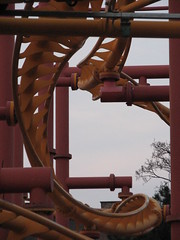 A drop, quick turn and then a heartline roll (geez, considering they’re rotating us a full 360 degrees you’d think they could design a better restraint system that holds us in comfortably whenever we’re not resting directly downward on the pad) and then a block brake. Seem to be surviving so far. The ride whips back into motion, giving the whole car and it’s riders a good jolt. “So far”, being the operative phrase of the sentence twice previous. I’m assuming the problem with roughness must be in the wheel assemblies and car design because the calculus of the track curvatures seems advanced enough from my perspective, but it does shutter around the track something awful. Lower speed sections aren’t too bad, but a final, high-speed s-turn that whips the car to a near 90 degree bank before slamming into an obnoxiously loud break run doesn’t earn the coaster or its designers any brownie points with a good finale.
A drop, quick turn and then a heartline roll (geez, considering they’re rotating us a full 360 degrees you’d think they could design a better restraint system that holds us in comfortably whenever we’re not resting directly downward on the pad) and then a block brake. Seem to be surviving so far. The ride whips back into motion, giving the whole car and it’s riders a good jolt. “So far”, being the operative phrase of the sentence twice previous. I’m assuming the problem with roughness must be in the wheel assemblies and car design because the calculus of the track curvatures seems advanced enough from my perspective, but it does shutter around the track something awful. Lower speed sections aren’t too bad, but a final, high-speed s-turn that whips the car to a near 90 degree bank before slamming into an obnoxiously loud break run doesn’t earn the coaster or its designers any brownie points with a good finale.
 Overall, good ride? No. Bad ride? Pretty much. Regrettable, as in 2002? Not really. I got off commenting to myself more over how much more painful it could easily have been, rather than how painful it actually was, and there’s no denying there’s few other experiences like it in the roller coaster world, for better or worse.
Overall, good ride? No. Bad ride? Pretty much. Regrettable, as in 2002? Not really. I got off commenting to myself more over how much more painful it could easily have been, rather than how painful it actually was, and there’s no denying there’s few other experiences like it in the roller coaster world, for better or worse.
By this time the sun had long since set, and I needed to start planning the end of my night. According to the RCDb there were nine coasters total for me to ride, one was down (Boomerang), and with the Volare now checked off that brings my count up to seven. What’s missing?
Ah, yes, the Auto BergBahn, a quirky children’s 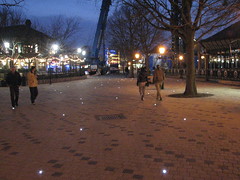 car ride which runs on gravity and I guess for that reason people are willing to deem it a coaster. Where was that thing? I spent my entire day with a thought in the back of my head reminding me to keep an eye out for such a contraption, and now that my day was nearly finished I still hadn’t caught sight of it. Was it near the entrance by the Riesenrad, Prater museum, and the large, bronze showman statue welcoming guests to the Prater? No. Was it on the pathway back behind the Hochschaubahn and a large open green park with a funky-retro train running around it? Not that I could see. Was it anywhere along one of the main midways, sandwiched between or behind the ridiculously oversized, 5-story tall walkthrough funhouses or ghost trains? Nope. Was it in the back corner of the park, between all the chestnut trees or nearby the historic
car ride which runs on gravity and I guess for that reason people are willing to deem it a coaster. Where was that thing? I spent my entire day with a thought in the back of my head reminding me to keep an eye out for such a contraption, and now that my day was nearly finished I still hadn’t caught sight of it. Was it near the entrance by the Riesenrad, Prater museum, and the large, bronze showman statue welcoming guests to the Prater? No. Was it on the pathway back behind the Hochschaubahn and a large open green park with a funky-retro train running around it? Not that I could see. Was it anywhere along one of the main midways, sandwiched between or behind the ridiculously oversized, 5-story tall walkthrough funhouses or ghost trains? Nope. Was it in the back corner of the park, between all the chestnut trees or nearby the historic 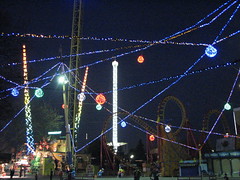 Schweizerhaus restaurant? Not that I could see. Even the children’s sections in the far back of the park, which appeared to be locked off for the night, I couldn’t see anything resembling the ride I was looking for. Unless it was somewhere else in the Prater parkgrounds that extend beyond the perimeter of the amusements area, the Auto BergBahn seemed to have been whipped off the map (which, indeed, had several listings for children’s “auto/bahn” type rides but none were what I wanted. Oh well, at least it gave me a chance to see the rest of the Prater after dark.
Schweizerhaus restaurant? Not that I could see. Even the children’s sections in the far back of the park, which appeared to be locked off for the night, I couldn’t see anything resembling the ride I was looking for. Unless it was somewhere else in the Prater parkgrounds that extend beyond the perimeter of the amusements area, the Auto BergBahn seemed to have been whipped off the map (which, indeed, had several listings for children’s “auto/bahn” type rides but none were what I wanted. Oh well, at least it gave me a chance to see the rest of the Prater after dark.
The Prater is pretty cheap and tacky, but it is also well maintained, and a times, even a little bit magical. Given the fact that it’s a patchwork tapestry built by several different  competing families over many, many generations, it’s sort of hard for it to not develop a unique characteristic not found at any other amusement park in the world, especially not at any of the large, corporately owned theme parks built to work as a destination attraction in their opening season as so many theme parks around Europe, North America and even farther are. The only real equivalent to the Prater I can think of is New York’s Coney Island, but that one has been marginalized and neglected by the city and its citizenry for the past several decades, and now that efforts are finally starting
competing families over many, many generations, it’s sort of hard for it to not develop a unique characteristic not found at any other amusement park in the world, especially not at any of the large, corporately owned theme parks built to work as a destination attraction in their opening season as so many theme parks around Europe, North America and even farther are. The only real equivalent to the Prater I can think of is New York’s Coney Island, but that one has been marginalized and neglected by the city and its citizenry for the past several decades, and now that efforts are finally starting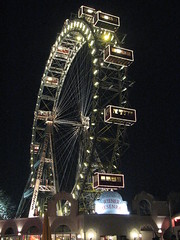 to turn it around, I see the efforts are to conglomerate and neutralize it into a singularly- owned vision. In that way the Prater is something truly special, and if the rides weren’t all so damned expensive it might even have been one of my favorite places in all of Europe, but with its current pricing structure I doubt I’d ever have the desire to return unless I was already in Vienna again for another reason (which, given what a richly-cultured and friendly city Vienna is, I’d say is more than likely to happen again sometime in my life).
to turn it around, I see the efforts are to conglomerate and neutralize it into a singularly- owned vision. In that way the Prater is something truly special, and if the rides weren’t all so damned expensive it might even have been one of my favorite places in all of Europe, but with its current pricing structure I doubt I’d ever have the desire to return unless I was already in Vienna again for another reason (which, given what a richly-cultured and friendly city Vienna is, I’d say is more than likely to happen again sometime in my life).
There was no other way to finish the night besides taking a ride on the Prater’s starring attraction, the 1897 built Wiener Riesenrad. The cost for one person was €8.50, but the personal cost of going to the Prater and deliberately not experiencing the Riesenrad was much higher. Since this ride is almost all about the views from the top, I’ll skip a written review of the ride to close out this essay, in favor of a photographic one found below.

Onride videos of Hochschaubahn, Megablitz and Super 8er Bahn
It’s some time since I had this, so correct me if I remember wrong:
Wiener Prater is not a perfectly competitive market or a free market, as there is barriers to entry. There is some function that decide which showman can put up an attraction at a certain space. Thus you have a limited number of supplier which then can choose a price closer to the monopoly price and supply fewer individual customers but making a bigger total profit. So in some way it is almost a monopoly, or at least an oligopoly
I’ve tried three scenic railways now, and they vary a lot. The one in Tivoli Gardens is by far the best one, and it have some good airtime. It probably delivers a more “aggressive ride” than most of the others!
Apparently free-markets are analogous to a rare, exotic pearl… breath-takingly beautiful when a perfect one is found, but even the slightest flaw will render it worthless. It seems a lot of the defensive literature I’ve read on free-markets such as that written by Milton Friedman claim that any argument indicating bad outcomes of free-markets aren’t valid because there’s some feature in the example that prevented them from working absolutely perfectly, and of course that therefore resulted in a partial oligopoly, etc., and of course that renders it wholly ruined (although examples of perfect free-market capitalism seem rather hard to find; if they’re so hard to cultivate and so easy to get wrong why do we stick with them as an economic system). Even if the Prater’s system isn’t a perfect embodiment of free-market ideals, my point is that it’s the closest we have in the amusement industry, while closed-gate attractions represent by comparison ‘monopolies’ in the extent that once you enter the park, they own every ride, food stand, gift shop, etc, and can impose whatever prices they want which vendors at the Prater don’t have the same unrestricted freedom to do. That is of course not counting the fact that they still remain in competition with other competing amusement parks in the region, but this distinction is technically no different for the Prater compared to any other closed-gate park.
I hope I made it clear enough later in the review about how I wouldn’t want the Prater any other way, except for not so expensive so I could have been able to afford to ride all of those great things you said they had instead of just looking at them sitting empty from the midway thinking to myself, “wow, how great would this place be if I could actually do everything here?” I think the comment about how Six Flags or Cedar Fair somehow represent the ‘ideal’ park setup over the Prater pretty clearly shows the hypocrisy (or at least conflict) I have with my argument. Admittedly it’s a bit silly in talking about this with a place like the Prater (which is why the whole essay was meant in sort of a fun, jesting way, not sure if my style of humor ever makes it across the screen) but hopefully it’s not too hard to see how the same critique can be applied in more serious, real-life situations which is my real interest in the topic.